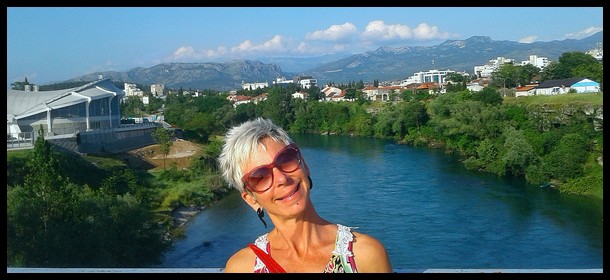
Lash at Moraca River – Podgorica – Montenegro
Introduction to Montenegro
Ok, fess up – Have you ever heard of the small country of Montenegro? And if so, do you know where it is or anything else about it?
I, for one, certainly didn’t know anything about Montenegro before I started planning out my travel agenda for 2019. I think I had at least heard of the country…but then again, I might have been thinking of Monte Carlo in France lol
In any event, you can entirely be forgiven for not knowing Montenegro… After all, it’s only been an independent country since 2006. Added to that, it’s a very small country on the Balkan Peninsula, far out-shadowed in size and travel fame by its neighboring Balkan countries of Bulgaria and Romania.
I actually just stumbled upon Montenegro when planning my travels around Europe this year. Quite unfortunately, Non-Europeans are only allowed to travel around Europe for three months before they have to leave – for another three months – before being allowed to return. Well!
That makes exploring Europe in any thorough, slow manner a real pain in the A**. I, for one, can barely explore all of ONE European country in three months, let alone the whole region.
Sadly, visiting Europe long-term requires quite a strategy of moving in and out of the Schengen region (That includes most EU countries, plus a few more non-EU countries, although UK is not in Schengen).
So, while planning my long-term European travel strategy, I was searching for countries to visit near Europe during my Schengen-off time. And that’s how I discovered Montenegro… along with several other small Balkan countries, including Albania, Kosovo and Macedonia.
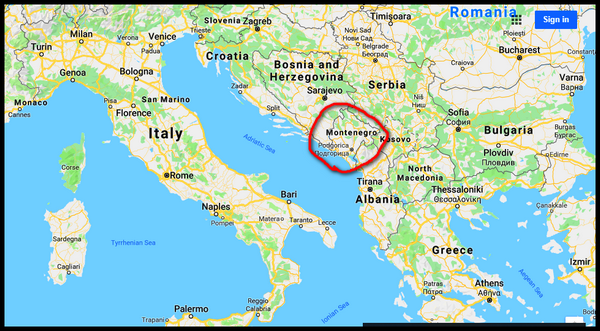 Location of Montenegro
Location of Montenegro
The Balkan Peninsula is located just east of Italy. The long narrow Adriatic Sea separates Italy’s long boot-shaped mainland from the Balkan coast. Directly across from Italy is Montenegro, sandwich-ed between Albania (to its south) and the long coast of Croatia (north of Montenegro).
As you can see from the map, Montenegro has a relatively short coastline on the Adriatic Sea. Most of the country’s territory consists of interior mountains. Montenegro is bordered on the interior by Bosnia-Herzgovia, Kosovo and Serbia.
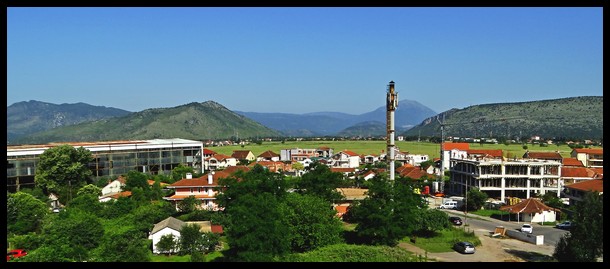 Recent History of Montenegro
Recent History of Montenegro
As mentioned, Montenegro became an independent nation only in 2006. It was carved out of the much bigger former Yugoslavia.
Yugoslavia was created in the aftermath of WWII in 1945 as a loose Republic of several Socialist Republics. One of the them was the Socialist Republic of Montenegro, pretty much a state within Yugoslavia. With a lot of warring and strive in the region, Yugoslavia was finally dissolved in 1991 and the various regions went adrift.
Montenegro first teamed up with Serbia to create a second Yugoslavia in 1992, which lasted until 2003, when they re-formed themselves as the nation of Serbia-Montenegro. Finally, in 2006, Montenegro separated from Serbia and formed its own country.
So although Montenegro is a new nation, the territory has been known as Montenegro since at least 1945.
When I arrived in Podgorica, the capital city, in June, I had a chat with my native taxi driver about the country’s history. He had a very interesting personal story to tell…
He was born in Yugoslavia. Several years later, he found himself living in second Yugoslavia Republic. A few years later he was living in Serbia-Montenegro. And now he’s living in Montenegro. So he has lived in four different countries during his life, thus far, without ever leaving his home town! How bizarre is that?!
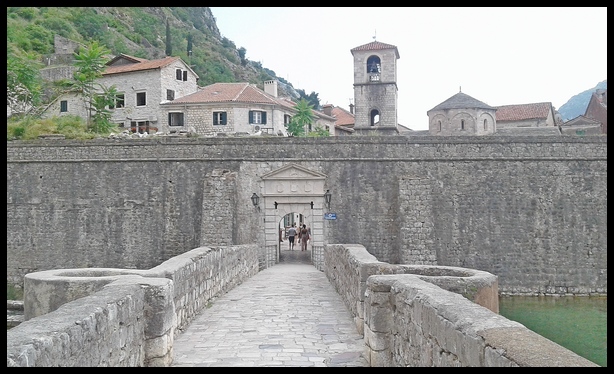
bridge to Kotor old town
Brief Ancient History of Montenegro
If you think the relatively recent history of Montenegro has been turbulent, that’s nothing compared to the long-term history of the region. Since around 1000 BC, the area has been occupied and carved up by several major civilizations.
The first known inhabitants were called Illirians, who occupied the area up until Roman Empire took over in the 2nd Century BC. For the next 700 years or so – until the Slavs arrived in 500s AD – the area was influenced and/or taken over at various times by Byzantines, Turkish Ottoman Empire, the Venetians and the Greeks.
Finally in the 500s AD the Slavs arrived. They’ve been in the area more or less ever since, though there have been many different Slavic tribes and various wars and power plays throughout that period.
I mention all this to point out that the current culture of the region has deep influences from several major cultures that have impacted the religion, cuisine, language, character and daily customs of the people.
Dotted around Montenegro are traces of all these former civilizations. There are Roman ruins, Greek Orthodox Churches, strong Greek and Turkish influence in the cuisine. The Montenegrin language is essentially Serbian.
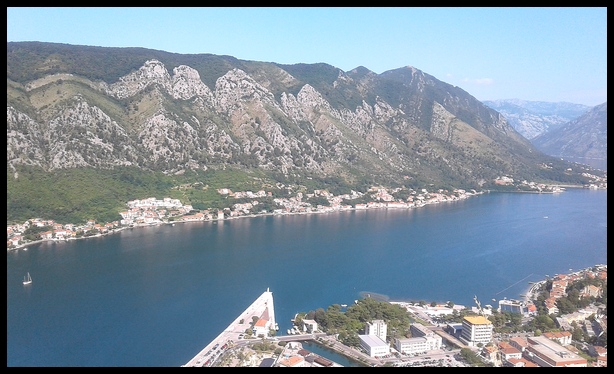
Kotor Bay
Nature & Topography of Montenegro
When I was researching for my 2019 travels, what really caught my attention about Montenegro was its gorgeous scenery. Along the coast there are several spectacular bays, beaches and the crystal-clear, turquoise Adriatic Sea. Inland there are pine forests, large lakes, high mountains, rivers and gorges.
Five mountainous national parks offer hiking, camping, canoe-ing and other outdoor pursuits in stunning mountains.
Now that I’m here and have traveled overland a bit, I have to say that the scenery and topography of Montenegro are even more spectacular in person!
Overwhelmingly, it’s a land full of rocks. Just about everywhere there are rocky mountains, sheer cliffs, meadows & fields dotted with huge rocks, stone and pebble beaches along the Adriatic Sea.
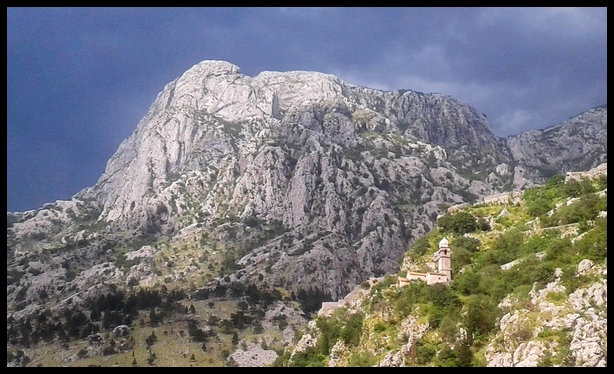 Secondly, it’s a country full of forests and lush greenery. Spring is a fantastic time to be here, as there are fragrant flowering trees, budding fruit trees, colorful delicate wild flowers, and large bushes bursting with flowers.
Secondly, it’s a country full of forests and lush greenery. Spring is a fantastic time to be here, as there are fragrant flowering trees, budding fruit trees, colorful delicate wild flowers, and large bushes bursting with flowers.
The Adriatic coast near Budva and Kotor are really spectacular. Kotor, in particular, is simply jaw-dropping. It consists of a series of long narrow, inter-connected bays, that snake inland from the sea. The final of these bays is Kotor Bay. It’s lined by such high, steep rocky mountains, that it’s often referred to as a fjord.
I still haven’t explored Montenegro’s interior mountainous national parks. But I’ll be heading there after Kotor to spend about two weeks hiking and camping. So I’ll be reporting more on Montenegro’s gorgeous scenery soon.
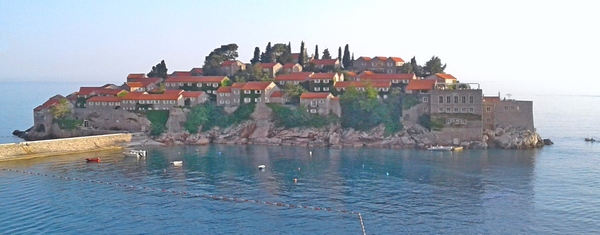 Culture and People
Culture and People
This is the first time I’ve visited a Slavic country or been surrounded primarily by Russians, Serbs and other people from Eastern Europe and the former Russian countries. The language(s) I hear on the streets, in restaurants and shops, is completely foreign to me.
And that’s pretty unusual for me as I’m accustomed to speaking the local languages of countries I visit. For the past three years I’ve been speaking Spanish in Mexico and Central America…even in Canary Islands, Barcelona and Portugal.
Two weeks into my travels here, I still only know one Serbian word – ‘Hvala’ (It sounds more or less like ‘voila’) and means ‘Thank you’ .
That’s better than nothing I suppose. But I guess I’d better up my game and learn a few more basic phrases like ‘Hello’ ‘Goodbye’ and ‘Where is.. xyx?’ ‘How much is…xyx?’ …and basic numbers. Especially if Serbian is spoken in several countries I’ll be visiting this year.
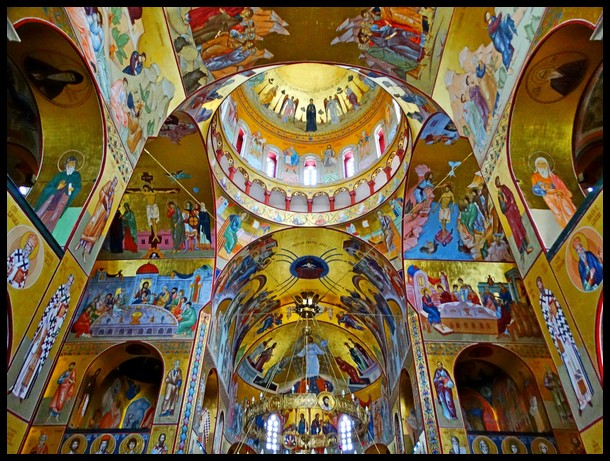
Greek Othodox Cathedral Podgorica
Medieval Towns and Serbian Orthodox Churches
Montenegro is also the first place I’ve visited real Serbian Orthodox Churches. Wowsers! Talk about elaborate and fancy interiors! I thought I’d seen elaborate churches in Mexico, Barcelona and Lisbon. But I think these churches rather outdo them all!
Several towns in Montenegro have ancient medieval stone towns set within high stone walls. Fortress cities. Luckily, they’ve been well-preserved. Some are UNESCO World Heritage Sites.
Thus far, I’ve visited the ‘old towns’ in Budva and Kotor. They are really adorable and quaint.
Several historic stone monasteries are set in mountains around the country. I’ve visited two so far. They make great hiking destinations and offer stunning views from their properties.
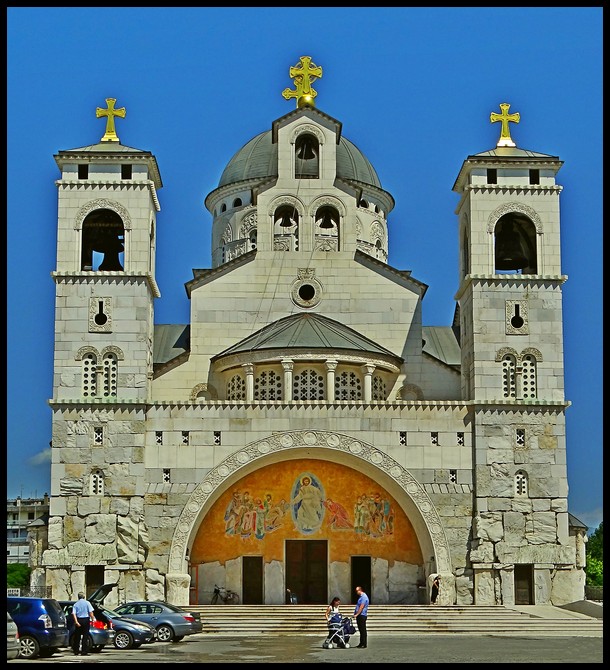 Local Cuisine
Local Cuisine
As for food, local cuisine includes several ‘pastry’ dishes that are pretty much the same as Greek cuisine. Bakeries everywhere here sell delicious spinach pies, cheese pies and spinach/cheese pies and meat pies. Gyros are fresh and easy to find as well.
There are several other Montenegrin dishes which I haven’t tried yet.
There’s a huge selection of fruits and vegetables, beef, chicken, sausages & salamis and pork. The beef is particularly high quality and delicious. Bakeries sell a variety of freshly baked breads. And all these foods are a fraction of the price of Europe or the USA.
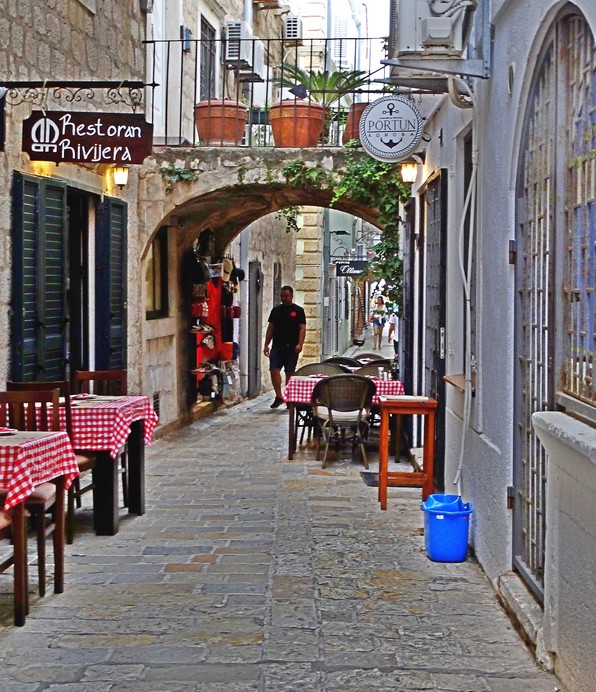 Costs of Budget Travel in Montenegro
Costs of Budget Travel in Montenegro
Besides the spectacular scenery, the other reason I was excited to visit Montenegro is that it’s much cheaper than Europe. I’ll be writing a whole post about costs of budget travel here, towards the end of my explorations of the country.
In the meantime, I can confirm that it’s pretty cheap to travel around Montenegro. And it’s certainly a fraction of the price of traveling through the main countries of Europe.
Fruits, vegetables, meats and baked goods cost 1/3 to ½ the price in Barcelona or Lisbon. Loaves of fresh baked bread cost as little as 50 cents to 1 Euro. A huge spinach or cheese pie costs about 1 Euro.
Bus transport is generally pretty cheap as well. I’ve recently paid 1.65 Euro for a 1-hour trip between local towns and 6 Euro from the capital city of Podgorica to the coastal tourist town of Budva, a 1.5-hour trip through the mountains.
Hostels cost around 8-10-15 Euro for a bed in a dorm in June, which is coming into high season. I’ve pretty much skipped staying in hostels, thank goodness. Private rooms on AirBnB & Booking cost 11-25 Euro and on up.
That gives you an idea of travel costs here. I’ll report my total costs after I’ve traveled for one month.
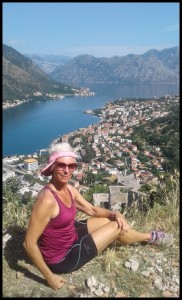 Summary
Summary
So that’s my introduction to Montenegro.
I’ve been here two weeks so far and in that time I’ve seen a lot of gorgeous scenery, eaten some tasty food, hiked in mountains, walked along the sea and visited a couple medieval walled cities & stone monasteries.
Thus far, I think Montenegro is fantastic!
I’ll be exploring for another two to three weeks, particularly visiting the national parks. So stay tuned for more about beautiful Montenegro.
Meanwhile, you might like:
Introduction to the Canary Islands
========================================================











 Hi! I'm Lash, an American nomadic world traveler who's been traveling solo since 1998. I’m passionate about traveling the world nomadically and then sharing it all with you. I hope to inspire you to travel the world, to entertain you with tales from the road, and to help you reach your travel dreams. Welcome!
Hi! I'm Lash, an American nomadic world traveler who's been traveling solo since 1998. I’m passionate about traveling the world nomadically and then sharing it all with you. I hope to inspire you to travel the world, to entertain you with tales from the road, and to help you reach your travel dreams. Welcome! 




5 pings
10 Best Places to Visit in Montenegro
2019/07/14 at 4:04 pm (UTC 8) Link to this comment
[…] Introduction to Montenegro […]
Costs of Budget Travel in Montenegro in 2019
2019/08/13 at 10:24 pm (UTC 8) Link to this comment
[…] you don’t know much about Montenegro, you might also want to check my Introduction to Montenegro or 17 Surprising Facts about […]
Costs of Budget Travel in Albania in 2019
2019/08/27 at 10:13 pm (UTC 8) Link to this comment
[…] My Introduction to Montenegro […]
Introduction to Krakow – Poland - LashWorldTour
2019/10/02 at 12:44 am (UTC 8) Link to this comment
[…] Introduction to Montenegro […]
My First Impressions of Istanbul – Turkey - LashWorldTour
2020/03/14 at 12:57 am (UTC 8) Link to this comment
[…] Intro to Montenegro […]